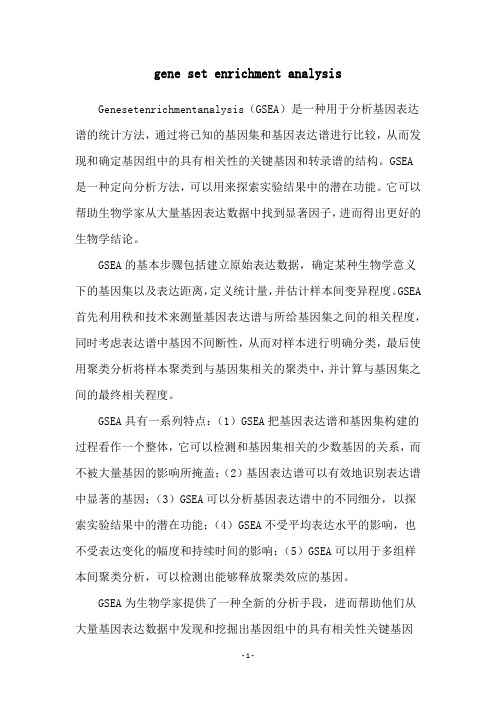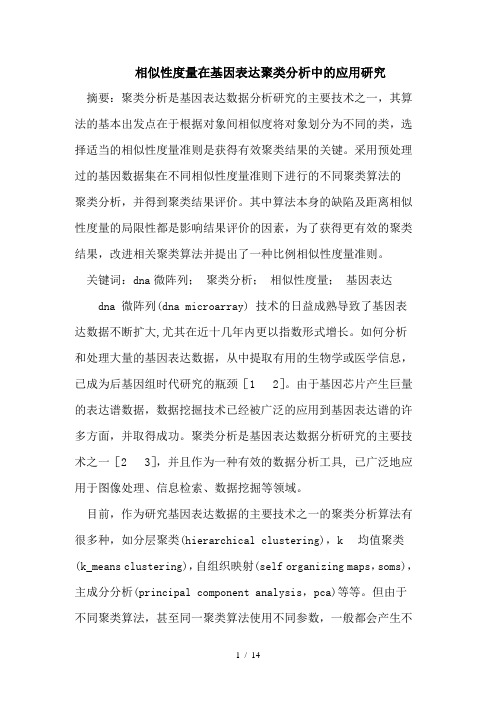从基因表达数据中发现知识摘要
gsea使用方法

gsea使用方法GSEA(Gene Set Enrichment Analysis)是一种常用的基因功能富集分析方法,可以帮助研究人员从大规模基因表达数据中发现与特定生物过程相关的基因集。
本文将介绍GSEA的使用方法,帮助读者了解如何利用GSEA进行基因功能富集分析。
一、GSEA的基本原理GSEA是一种基于基因集的分析方法,与传统的基因差异分析方法不同。
传统的基因差异分析方法主要关注单个基因是否显著差异表达,而GSEA则将基因集作为一个整体来进行分析。
GSEA的基本原理是通过计算基因集在基因表达数据中的富集程度来判断该基因集是否与某个生物过程相关。
具体而言,GSEA首先将基因根据其表达水平进行排序,然后计算基因集在排序列表中的富集得分。
富集得分高表示基因集在排序列表的前端或后端有显著富集,从而提示该基因集与特定的生物过程相关。
二、GSEA的使用步骤1. 数据准备:首先需要从公共数据库或自己实验得到基因表达数据,通常是一个基因表达矩阵。
此外,还需要一个基因集数据库,例如GO(Gene Ontology)数据库、KEGG(Kyoto Encyclopedia of Genes and Genomes)数据库等。
2. 数据预处理:对基因表达数据进行预处理,包括数据清洗、归一化、去除批次效应等。
这样可以确保数据质量和可比性。
3. 基因集定义:选择一个或多个与研究目的相关的基因集,可以基于GO注释、KEGG通路等。
也可以根据文献报道或专家知识自定义基因集。
4. 运行GSEA:使用GSEA软件加载基因表达数据和基因集数据库,设置参数并运行GSEA分析。
参数设置包括:基因集数据库的选择、分析类型(单样本或双样本)、排列次数等。
GSEA分析可能需要大量的计算资源,可以选择在本地计算机或集群上运行。
5. 结果解读:GSEA分析的结果通常包括富集得分图、富集基因集表和富集通路图等。
富集得分图反映了基因集在排序列表中的富集程度,富集基因集表列出了在排序列表中富集得分高的基因集,富集通路图则可视化了基因集与生物通路的关系。
基因表达方式

基因表达方式摘要:1.基因表达方式的定义和重要性2.基因表达的两种方式:转录和翻译3.转录过程的详细步骤4.翻译过程的详细步骤5.基因表达调控的重要性及其方式6.基因表达调控在生物体中的作用7.我国在基因表达调控研究方面的进展正文:基因表达方式是指基因信息从DNA传递到蛋白质的过程。
这个过程对生物体的生长、发育和细胞功能调控至关重要。
基因表达分为两种方式:转录和翻译。
转录是指在细胞核内,RNA聚合酶将DNA上的基因信息转录成mRNA 的过程。
这个过程分为以下几个步骤:首先,RNA聚合酶与基因启动子区域结合,形成转录起始复合物。
接着,RNA聚合酶沿着DNA模板链进行延伸,合成mRNA。
然后,RNA聚合酶从DNA模板链上脱离,完成mRNA的生成。
最后,生成的mRNA通过核孔复合物从细胞核中释放出来,进入细胞质。
翻译是指在细胞质中,核糖体将mRNA上的遗传信息翻译成蛋白质的过程。
这个过程分为以下几个步骤:首先,核糖体结合到mRNA上,从起始密码子开始进行翻译。
接着,核糖体沿着mRNA移动,将每个氨基酸连接成蛋白质多肽链。
然后,在终止密码子处,核糖体从mRNA上脱离,完成蛋白质的翻译。
最后,新生成的蛋白质具有特定的功能,参与细胞的各种生物学过程。
基因表达调控是指通过各种机制对基因表达进行精细调控的过程,包括基因启动子、增强子、沉默子和阻遏物的调控。
基因表达调控在生物体中的作用主要体现在以下几个方面:1) 控制基因在特定时间和空间表达,确保生物体的生长、发育和功能正常;2) 响应环境变化,使生物体能够适应不同的生长环境;3) 维持基因表达的稳定,防止基因突变和遗传信息的改变。
我国在基因表达调控研究方面取得了显著进展,不仅在基础研究方面积累了丰富的经验,而且在应用研究方面也取得了突破。
例如,我国科研人员已经在基因表达调控的机制研究、基因表达调控在疾病治疗中的应用等方面取得了一定的成果。
生物大数据技术的通路分析方法与工具

生物大数据技术的通路分析方法与工具随着现代生物学研究的发展和高通量生物数据的不断积累,生物大数据技术逐渐成为生物学研究的重要工具。
对于生物学家来说,了解如何分析和解读生物大数据是至关重要的。
通路分析作为生物大数据分析的重要组成部分,旨在揭示基因、蛋白质以及其他生物分子相互作用的关系网络。
本文将介绍生物大数据技术的通路分析方法与工具,以帮助生物学家更好地理解和应用这一领域的知识。
通路分析是一种从全局角度分析基因或蛋白质与其它生物分子之间相互作用关系的方法。
通路是一个生物学过程的简化模型,可以帮助我们理解基因或蛋白质在细胞中的功能和相互作用。
通常,通路分析的第一步是收集大量的生物数据,如基因表达数据、蛋白质相互作用数据等。
随后,通过通路分析工具对这些数据进行整合和解读,从而揭示其内在的生物学意义。
一种常用的通路分析方法是基于基因集富集分析(gene set enrichment analysis,GSEA)。
GSEA通过将基因表达或蛋白质相互作用数据与已知的生物学通路进行比较,来鉴定在给定生物过程或疾病中具有显著差异的通路。
这种方法不仅可以帮助研究者了解基因或蛋白质的功能,还可以揭示一系列基因或蛋白质在特定生物过程中的相互作用网络。
除了GSEA,还有一些其他的通路分析方法和工具可供选择。
例如,Pathway Mapper是一个常用的在线工具,用于可视化和解释基因表达数据在生物通路中的变化。
它可以帮助生物学家从基因表达数据中发现与特定生物功能或疾病相关的通路。
此外,Cytoscape是一个开源的网络分析工具,可以用于生物网络的可视化和分析。
它提供了丰富的插件库,可以用于通路分析、基因调控网络分析等。
Cytoscape不仅可以帮助生物学家发现与生物过程相关的通路,还可以帮助他们理解和预测基因或蛋白质与其他生物分子之间的相互作用。
除了这些通用的通路分析方法和工具之外,还有一些针对特定生物过程或疾病的通路分析方法和工具。
gene set enrichment analysis

gene set enrichment analysisGenesetenrichmentanalysis(GSEA)是一种用于分析基因表达谱的统计方法,通过将已知的基因集和基因表达谱进行比较,从而发现和确定基因组中的具有相关性的关键基因和转录谱的结构。
GSEA是一种定向分析方法,可以用来探索实验结果中的潜在功能。
它可以帮助生物学家从大量基因表达数据中找到显著因子,进而得出更好的生物学结论。
GSEA的基本步骤包括建立原始表达数据,确定某种生物学意义下的基因集以及表达距离,定义统计量,并估计样本间变异程度。
GSEA 首先利用秩和技术来测量基因表达谱与所给基因集之间的相关程度,同时考虑表达谱中基因不间断性,从而对样本进行明确分类,最后使用聚类分析将样本聚类到与基因集相关的聚类中,并计算与基因集之间的最终相关程度。
GSEA具有一系列特点:(1)GSEA把基因表达谱和基因集构建的过程看作一个整体,它可以检测和基因集相关的少数基因的关系,而不被大量基因的影响所掩盖;(2)基因表达谱可以有效地识别表达谱中显著的基因;(3)GSEA可以分析基因表达谱中的不同细分,以探索实验结果中的潜在功能;(4)GSEA不受平均表达水平的影响,也不受表达变化的幅度和持续时间的影响;(5)GSEA可以用于多组样本间聚类分析,可以检测出能够释放聚类效应的基因。
GSEA为生物学家提供了一种全新的分析手段,进而帮助他们从大量基因表达数据中发现和挖掘出基因组中的具有相关性关键基因和转录谱的结构,从而建立和证明自然环境中的细胞行为。
GSEA的应用非常广泛,可以用于寻找复杂疾病的相关基因,而且在发现药物治疗标志物等方面也非常有效。
GSEA的应用不仅仅限于生物学领域,它也可以应用于医学、农学和农艺学等领域。
由于GSEA具有许多优点,现在很多研究人员开始使用GSEA来解决实验问题。
GSEA可以用来从大量的基因表达数据中获取更多的信息,有助于生物学家了解基因组编码的功能,从而更好地理解生物学现象。
生物信息文献总结范文

摘要:随着生物技术的飞速发展,生物信息学作为一门新兴的交叉学科,在疾病研究中的应用越来越广泛。
本文对生物信息学在疾病研究中的应用进行了综述,并分析了近年来生物信息学在疾病研究中的最新进展。
一、引言生物信息学是生物学、计算机科学和数学相互交叉的学科,利用计算机技术对生物数据进行处理、分析和解释。
在疾病研究中,生物信息学通过对大量生物数据的挖掘和分析,为疾病的发生、发展和治疗提供了新的思路和方法。
二、生物信息学在疾病研究中的应用1. 基因组学研究基因组学是研究生物体基因组的结构和功能的一门学科。
生物信息学在基因组学中的应用主要体现在以下几个方面:(1)基因注释:通过对基因组序列进行注释,确定基因的功能、位置和表达水平。
(2)基因发现:通过生物信息学方法,从基因组数据中识别新的基因和基因家族。
(3)基因变异分析:分析基因变异与疾病之间的关系,为疾病诊断和治疗提供依据。
2. 蛋白质组学研究蛋白质组学是研究生物体蛋白质组成和功能的一门学科。
生物信息学在蛋白质组学中的应用主要体现在以下几个方面:(1)蛋白质序列分析:通过生物信息学方法,分析蛋白质序列的结构、功能和进化关系。
(2)蛋白质相互作用网络分析:构建蛋白质相互作用网络,揭示蛋白质之间的相互作用关系。
(3)蛋白质功能预测:通过生物信息学方法,预测蛋白质的功能和调控机制。
3. 转录组学研究转录组学是研究生物体基因表达水平的一门学科。
生物信息学在转录组学中的应用主要体现在以下几个方面:(1)基因表达数据分析:通过生物信息学方法,分析基因表达数据,识别差异表达基因。
(2)基因调控网络分析:构建基因调控网络,揭示基因之间的调控关系。
(3)生物标记物发现:通过生物信息学方法,发现与疾病相关的生物标记物。
三、生物信息学在疾病研究中的最新进展1. 大数据分析随着生物技术的快速发展,生物数据量急剧增加。
大数据分析技术在生物信息学中的应用,使得研究人员能够从海量数据中挖掘有价值的信息。
如何利用机器学习进行生物信息学数据分析(Ⅱ)

生物信息学是指将计算机科学和生物学相结合,利用计算机科学的方法来处理和分析生物学数据。
机器学习是一种人工智能的分支,它使计算机能够从数据中学习和提高性能。
利用机器学习技术进行生物信息学数据分析,可以帮助研究人员更好地理解生物学现象,发现新的生物学规律和模式,为生物学研究提供新的思路和方法。
本文将探讨如何利用机器学习技术进行生物信息学数据分析。
生物信息学数据的特点生物信息学数据通常具有以下特点:大规模、高维度、复杂性和噪声。
例如,基因组学数据、蛋白质组学数据和代谢组学数据等,都是大规模的、高维度的数据。
这些数据可能包含成千上万个特征,如基因表达水平、蛋白质结构和代谢产物浓度等,而且这些特征之间可能存在复杂的相互作用关系。
此外,生物信息学数据通常还存在一定的噪声,例如仪器误差、实验误差和样本异质性等。
因此,对生物信息学数据进行有效的分析和挖掘是一项具有挑战性的任务。
机器学习在生物信息学中的应用机器学习技术可以帮助研究人员从生物信息学数据中发现隐藏的模式和规律,实现生物学数据的分析和解释。
目前,机器学习在生物信息学中已经得到了广泛的应用,包括基因表达分析、蛋白质结构预测、代谢产物鉴定等方面。
基因表达分析是生物信息学中的一个重要研究领域。
通过测量和分析基因的表达水平,可以揭示基因在不同生物学过程中的功能和调控机制。
机器学习技术可以帮助研究人员从基因表达数据中挖掘出基因表达模式和基因调控网络,发现与生物学现象相关的基因和基因组特征。
通过机器学习技术,研究人员可以识别出与疾病相关的基因标志物,预测疾病的发生和进展,为疾病的预防、诊断和治疗提供新的线索和方法。
蛋白质结构预测是另一个生物信息学研究的热点领域。
蛋白质是生物体内最重要的功能分子之一,其结构与功能密切相关。
然而,实验测定蛋白质结构的方法通常耗时耗力,并且成本较高。
因此,利用计算方法预测蛋白质结构成为了一种重要的研究手段。
机器学习技术可以帮助研究人员从已知的蛋白质结构数据中学习并预测出新的蛋白质结构,为生物学研究和药物设计提供有力的支持。
生物信息学软件

生物信息学软件生物信息学软件是在生物信息学领域中广泛应用的工具,可以帮助研究者分析、处理和管理大量的生物学数据。
这些软件包括了各种各样的功能和工具,使得生物信息学在许多生命科学研究中得到了广泛的应用。
首先,生物信息学软件能够处理和分析基因组数据。
基因组学是生物信息学的一个重要分支,它关注的是基因组的结构和功能。
生物信息学软件可以帮助研究人员在基因组序列中找到基因和其他功能元件,以及预测它们的功能和调控机制。
这些工具还可以进行基因组比对和注释,帮助研究人员理解基因组中的遗传变异。
其次,生物信息学软件还可以处理和分析蛋白质序列和结构数据。
蛋白质是生命活动的基本单位,对于了解生物学过程和疾病机理非常重要。
生物信息学软件可以进行蛋白质序列的比对和注释,帮助研究人员预测蛋白质的结构和功能。
此外,这些软件还可以进行蛋白质互作网络的分析和模拟,有助于研究人员理解蛋白质相互作用的机制。
另外,生物信息学软件还可以处理和分析转录组数据。
转录组学研究的是在不同条件下,细胞中所有基因的转录水平的综合。
生物信息学软件可以帮助研究人员在大规模基因表达数据中发现差异表达的基因,并进行功能富集分析和通路分析,从而了解基因在不同生物学过程中的功能和调控网络。
此外,生物信息学软件还可以进行进化分析,揭示物种间的亲缘关系和演化历史。
通过比对多个物种的基因组序列,可以确定它们之间的进化关系,并重建它们的进化历史。
这些软件还可以进行种系发育树的构建和分析,帮助研究人员理解物种的分类和进化。
总而言之,生物信息学软件在生命科学研究中发挥着重要的作用。
它们能够处理和分析各种类型的生物学数据,帮助研究者理解生物学现象和解决生物学问题。
随着科技进步和生物学研究的发展,生物信息学软件的功能和性能也在不断提升,为生物学研究提供了有力的支持。
然而,需要注意的是,生物信息学软件在使用过程中也存在一些挑战和局限性。
首先,生物信息学软件通常需要一定的编程和统计知识才能正确地运行和解释结果。
基因研究基因组数据挖掘

基因研究基因组数据挖掘基因研究与基因组数据挖掘基因研究是生物学中的重要方向之一,它向我们揭示了生命的奥秘和遗传的规律。
而基因组数据挖掘则是一项利用计算机算法和统计学方法来挖掘和分析大量基因组数据的技术。
本文将探讨基因研究与基因组数据挖掘之间的关系以及它们对生物学研究的意义。
基因组数据挖掘是在全基因组和全基因组表达水平上,通过使用计算工具和大规模数据分析来发现遗传变异和基因之间的相关性。
通过基因组数据挖掘,研究人员能够更深入地了解基因组中潜在的功能、表达模式和相关疾病。
此外,利用大数据分析方法,基因表达谱和基因组数据的关联分析也成为了一项研究热点。
这些研究的结果不仅能够帮助我们更好地理解生命的本质,而且对于疾病的诊断和治疗也具有重要意义。
基因研究作为一门多学科的领域,将生物学、遗传学、计算机科学等多种学科技术有机地结合起来。
通过基因研究和基因组数据挖掘,研究人员能够揭示基因与表型之间的关联,包括疾病的起源和发展机制。
以癌症为例,通过对基因组数据的挖掘和分析,我们可以发现潜在的致病基因和治疗靶点,为癌症的早期诊断和治疗提供新的思路。
另外,基因组数据挖掘还可以帮助我们理解种群遗传学和人类进化。
通过比较不同人群的基因组数据,我们可以推测他们之间的遗传差异和人类演化的历史。
此外,基因组数据的挖掘还可以帮助我们研究物种起源和进化过程中的基因变异,进一步揭示生命的多样性和适应性。
随着高通量测序技术的快速发展和数据存储处理能力的提升,基因组数据的规模和复杂性不断增加。
这使得基因组数据挖掘成为了一个巨大的挑战,需要利用先进的算法和工具来处理和分析。
例如,机器学习和人工智能技术的应用,可以帮助我们从大量基因组数据中发现模式和规律,加速生物学研究的进程。
尽管基因组数据挖掘在生物学研究中发挥着重要作用,但也面临着一些挑战。
首先,基因组数据的质量和准确性对于后续分析的可靠性至关重要。
因此,研究人员需要注意数据的采集、处理和标准化等环节,以确保数据的可靠性。
生物信息学中的基因差异表达分析教程

生物信息学中的基因差异表达分析教程生物信息学是一门综合性的学科,结合生物学、计算机科学和统计学等领域的知识,致力于研究和分析生物大数据。
基因差异表达分析是生物信息学中的一个重要研究方向,它帮助我们了解基因在不同生物样本中的表达差异,从而揭示基因在生物体内的功能和调控机制。
本文将介绍基因差异表达分析的基本步骤和常用分析方法。
1. 数据获取基因差异表达分析的第一步是获取表达谱数据。
目前,公共数据库如GEO、TCGA、ENCODE等提供了大量的生物学实验数据,我们可以从这些数据库中下载需要的数据。
此外,还可以使用RNA-seq技术生成自己的表达谱数据。
2. 数据预处理在分析之前,我们需要对原始数据进行预处理。
这包括数据清洗、去除低质量的读数、去除rRNA等非编码RNA和抹平库大小差异等。
对于RNA-seq数据,通常还需要对原始测序reads进行碱基质量评估和去除接头序列。
预处理后的数据为下一步的分析做好准备。
3. 基因表达量估计在差异表达分析中,我们需要估计每个基因的表达量。
对于RNA-seq数据,可以使用软件如TopHat、HISAT2等进行reads比对,然后使用Cufflinks、StringTie等软件估计基因表达量。
对于芯片数据,可以使用MAS5、RMA等算法估计基因表达量。
4. 基因差异分析基因表达量估计后,就可以进行基因差异分析了。
差异表达分析可以帮助我们找到在不同样本中表达差异显著的基因。
常用的差异表达分析方法包括DESeq2、edgeR和limma等。
这些方法可以计算统计学上的显著性差异,并生成差异基因列表。
5. 功能富集分析差异表达基因的功能富集分析是了解这些基因在生物学过程中扮演的角色的关键步骤。
功能富集分析可以帮助我们发现差异显著的基因在分子功能、细胞组成和生物过程等方面的富集。
常用的功能富集分析工具包括DAVID、GSEA和Enrichr等。
6. 可视化和解释结果完成差异表达分析后,我们需要将结果进行可视化和解释。
数据科学在生物信息学中的应用与发展

数据科学在生物信息学中的应用与发展数据科学是一门跨学科的领域,结合了统计学、计算机科学、数学和领域知识,旨在从大量的数据中提取知识和洞察力。
生物信息学是数据科学在生物科学和生物医学领域的应用,它利用计算技术来分析生物学数据,如基因组学、蛋白质组学和代谢组学等。
以下是数据科学在生物信息学中的应用与发展的知识点:1.基因表达数据分析:数据科学在基因表达数据分析中扮演重要角色,通过分析基因表达数据可以了解基因在不同条件下的表达水平,进而揭示基因调控网络和生物通路。
2.基因组组装:数据科学方法被广泛应用于基因组组装,通过分析测序读取数据来构建基因组的完整序列。
这有助于揭示未知基因和了解基因组结构。
3.变异分析:数据科学在变异分析中用于识别和解释基因组中的变异,包括单核苷酸多态性和结构变异。
这有助于研究遗传病和癌症等疾病的基因遗传因素。
4.生物标志物发现:数据科学方法被用于从生物样本数据中发现生物标志物,这些标志物可以用于疾病的诊断、预后和治疗。
5.药物发现与设计:数据科学在药物发现和设计中发挥重要作用,通过分析蛋白质靶标和药物分子的相互作用,可以预测药物的效果和副作用,加速新药的研发过程。
6.系统生物学:数据科学方法被用于分析系统生物学实验数据,如蛋白质相互作用网络和代谢网络,以揭示生物系统的调控机制和功能。
7.宏基因组学:数据科学在宏基因组学中用于分析环境样本中的微生物群落,可以揭示微生物多样性、功能和相互作用。
8.数据共享与生物信息学数据库:数据科学在生物信息学数据库的构建和维护中发挥作用,通过整合和共享生物学数据,可以促进科研合作和知识发现。
9.人工智能与机器学习:数据科学中的人工智能和机器学习技术在生物信息学中得到广泛应用,如预测蛋白质结构、识别生物标志物和个性化医疗等。
10.云计算与大数据分析:数据科学在生物信息学中需要处理和分析大规模的数据集,云计算和大数据分析技术提供了高效的计算资源和数据管理能力。
生物信息学中的基因表达分析技术

生物信息学中的基因表达分析技术基因是生命的基本单位,它们参与到了生命的各个方面,包括细胞的生长、分化、代谢以及ECM(细胞外基质)组成。
基因表达是指基因通过转录与翻译等方式转化为蛋白质或RNA,这个过程决定了一个细胞的特性和生物活动的结果。
为了探究生命的各种细节,基因表达的分析必不可少。
而生物信息学中的基因表达分析技术,是最常用且最有效的方法之一。
基因表达分析的种类在基因表达分析中,有很多种技术可供选择,具体的选择取决于研究者的研究问题和所处的研究领域。
以下列出了一些常用的技术。
1. 基于测序数据的分析技术测序是分析基因表达中最常用的技术之一。
它可以通过RNA测序、全基因测序或甲基化测序等方式进行。
通过测序技术,可以获得大量的基因表达数据,包括基因的转录本和外显子序列等。
这些数据可以帮助识别基因表达的差异和变化。
2. 基于芯片数据的分析技术芯片技术也是基因表达分析中常用的技术。
该技术通过搭载特定的探针,同时测量成千上万个基因的表达情况,从而得到大量的基因表达数据。
芯片技术具有快速和高通量的优点,同时又可以适应多样的生物样品类型。
3. 蛋白质和翻译后修饰分析技术虽然RNA只是突出了基因表达的一个方面,但它在细胞生命周期的不同阶段和不同环境中都有不同的功能。
对于细胞进行全面的基因表达分析,需要进行蛋白质和翻译后修饰分析,以获取基因表达的全景图。
从基因表达到蛋白质表达,需要经过多个步骤的转换,因此,这种分析技术非常复杂。
基因表达分析的主要目的通过基因表达分析,可以实现多种研究目的。
以下列举了其中几个主要的目的。
1.研究基因的功能和调控机制基因表达分析可以帮助科学家研究一个基因在特定条件下的表达水平和调控机制。
例如,通过对不同样本中的特定基因进行分析,可以发现基因的表达和某种疾病之间的相关性。
2.发现化合物和聚集物分子基因表达分析可以实现从基因到蛋白质和聚集物分子的全景图分析。
例如,可以通过分析特定临床样本中的蛋白质表达,发现可能与某种疾病相关的化合物和分子。
生命科学领域中的数据挖掘和分析

生命科学领域中的数据挖掘和分析近年来,生命科学领域中的数据挖掘和分析技术得到了快速的发展,并且取得了一系列重要成果。
生命科学领域的数据具有高维、复杂和非常规等特点,如何从数据中提取有价值的信息并进一步应用于疾病诊断、治疗和预防等方面,是生命科学领域需要解决的重要问题之一。
一、DNA序列分析DNA序列是生命科学领域中最常见的数据之一。
DNA序列分析是研究生物学基本问题和众多生物技术应用的关键。
DNA序列分析的数据挖掘和分析技术可以帮助人们发现基因的位置、功能和变异等信息,并对疾病的诊断和治疗提供参考。
例如,生物学家利用数据挖掘和分析技术发现了一些与肿瘤相关的基因。
这些基因的突变可能导致细胞增殖或凋亡异常,从而导致癌症的发生。
这些基因的发现为癌症的诊断和治疗提供了重要的支持。
二、蛋白质分析蛋白质是生命体内最重要的功能分子。
蛋白质的结构和功能对于解决生命科学中的很多问题具有重要意义。
蛋白质分析的数据挖掘和分析技术可以从蛋白质结构中发现重要的结构特征,并推断蛋白质的复杂功能。
例如,研究人员利用数据挖掘和分析技术发现了一种新的蛋白质结构,该结构具有与蛇毒素相似的特点。
通过研究这种新蛋白质的功能,科学家可以开发新的药物用于治疗蛇毒等疾病。
三、代谢组学分析代谢组学是指通过系统性分析生物体内小分子代谢物的变化,建立物质代谢的全局模型,从而实现对生物体代谢状态的研究。
代谢组学的数据挖掘和分析技术可以发现代谢物的表达模式和相互关系,并提供对复杂代谢网络的理解。
例如,利用数据挖掘和分析技术,研究人员发现了一种新型抗生素,该抗生素来源于某种细菌的代谢产物。
研究人员通过对代谢产物的分析,发现这种抗生素具有广谱抗菌作用,可以用于对多种疾病的治疗。
四、疾病预测分析数据挖掘和分析技术在疾病预测方面也具有广泛的应用前景。
例如,利用基因芯片数据和机器学习算法,可以将病人的基因表达数据与健康人的基因表达数据进行比较,并从中发现疾病相关基因、基因信号通路等信息。
从杨树基因组表达谱芯片数据中挖掘树木生长发育规律的研究

探讨 动植 物丰 富基 因资源 及其遗 传表 现正 成为 动植物 育
种改 良的研究热点 。
因组( 8M ) 约45 b , 与水稻 的相 近 , 仅为拟南芥 的4 , 倍 松树的 1 0( ) / ;2杨属植物 有丰富的遗传多样性 ;3) 4 ( 已建立多个高
效、 稳定 的杨树遗传转 化系统 ;4) 多数 杨树可 以无 性繁 ( 大
息 的分析 和调控技术 , 为解 决动植 物生长发 育与环境协 同 发展 的复杂性研究提供 了可能 。
森林 是最重 要的 陆地生态 系统 , 并且 是人类 最主要 的
可持续 利用 资源 。 而杨树 因具 备 以下 几个特性 已被广泛接 受 为林 木基 因组研 究 的模式 树种 : 1) 有一 个较小 的基 ( 具
关键 词: 杨树 ; 因组 计划; 因芯片; 基 基 数据挖掘 中图分类号¥ 9 . 1 7 2 1 文献标识码A 文章编号 1 0 — 7 1( )0 — 3 — 0 7 7 0 3 21 0 0 60 803
S ud n t w f Tr e Gr wt nd De e o t y o he La o e o h a v l pm e tM i e r m e o p e s o i r a r y Da a o n n d f o G n me Ex r s i n M c o r a t f
1研 究 目的
随着 分子 生物 学和农 林科 学 的交叉渗 透, 林科 学 的 农 研 究 已从动植 物 的个体水 平不 断向微观 和宏 观延伸 ; 生物 技术、 信息 技术 等新方 法与农 林科 学传 统方 法 的结合 , 使 农林 科 学的研 究手 段 日益更新 和完 善 。 从多 学科 、 角度 多
动物实验报告学期小结(3篇)

第1篇一、前言本学期,我参加了动物实验课程的学习,通过一系列的动物实验,我对生物学的基本原理和方法有了更深入的了解。
以下是对本学期动物实验的学习心得和总结。
二、实验内容概述本学期,我们进行了多个动物实验,主要包括以下几个方面:1. 动物解剖实验:通过对不同动物(如青蛙、小鼠等)的解剖,了解动物内部器官的结构和功能。
2. 组织切片实验:学习制作动物组织切片,观察细胞和组织的细微结构。
3. 生化实验:通过动物实验,学习检测血液、尿液等生物样品中的生化指标。
4. 免疫学实验:学习动物免疫系统的基本原理,进行抗原-抗体反应实验。
5. 行为学实验:观察动物在不同环境下的行为表现,了解动物行为与神经系统之间的关系。
三、实验过程及心得1. 动物解剖实验在动物解剖实验中,我学会了如何解剖青蛙、小鼠等动物,了解了动物内部器官的形态和功能。
通过实验,我认识到动物解剖是研究生物学的重要方法,有助于我们深入理解生物体的结构和功能。
2. 组织切片实验在组织切片实验中,我学会了如何制作动物组织切片,并使用显微镜观察细胞和组织的细微结构。
通过实验,我掌握了组织切片的制作方法,提高了观察细胞和组织的能力。
3. 生化实验在生化实验中,我学习了检测血液、尿液等生物样品中的生化指标。
通过实验,我了解了生化指标在疾病诊断和健康评估中的重要作用。
4. 免疫学实验在免疫学实验中,我学习了动物免疫系统的基本原理,并进行了抗原-抗体反应实验。
通过实验,我掌握了免疫学的基本知识,提高了对免疫学实验的操作能力。
5. 行为学实验在行为学实验中,我观察了动物在不同环境下的行为表现,了解了动物行为与神经系统之间的关系。
通过实验,我认识到行为学在研究动物生理和心理活动中的重要性。
四、实验收获与反思1. 收获(1)掌握了动物实验的基本原理和方法,提高了实验操作能力。
(2)深入了解了生物学的基本知识,为今后的学习奠定了基础。
(3)培养了严谨的科学态度和团队协作精神。
相似性度量在基因表达聚类分析中的应用研究

相似性度量在基因表达聚类分析中的应用研究摘要:聚类分析是基因表达数据分析研究的主要技术之一,其算法的基本出发点在于根据对象间相似度将对象划分为不同的类,选择适当的相似性度量准则是获得有效聚类结果的关键。
采用预处理过的基因数据集在不同相似性度量准则下进行的不同聚类算法的聚类分析,并得到聚类结果评价。
其中算法本身的缺陷及距离相似性度量的局限性都是影响结果评价的因素,为了获得更有效的聚类结果,改进相关聚类算法并提出了一种比例相似性度量准则。
关键词:dna微阵列;聚类分析;相似性度量;基因表达dna 微阵列(dna microarray) 技术的日益成熟导致了基因表达数据不断扩大,尤其在近十几年内更以指数形式增长。
如何分析和处理大量的基因表达数据,从中提取有用的生物学或医学信息,已成为后基因组时代研究的瓶颈[12]。
由于基因芯片产生巨量的表达谱数据,数据挖掘技术已经被广泛的应用到基因表达谱的许多方面,并取得成功。
聚类分析是基因表达数据分析研究的主要技术之一[23],并且作为一种有效的数据分析工具, 已广泛地应用于图像处理、信息检索、数据挖掘等领域。
目前,作为研究基因表达数据的主要技术之一的聚类分析算法有很多种,如分层聚类(hierarchical clustering),k均值聚类(k_means clustering),自组织映射(self organizing maps,soms),主成分分析(principal component analysis,pca)等等。
但由于不同聚类算法,甚至同一聚类算法使用不同参数,一般都会产生不同的聚类结果。
因此,在对数据处理过的基因表达矩阵聚类分析时,选择合适的聚类相似性准则至关重要,同时也是获得合理、精确的聚类结果的关键。
1dna微阵列dna微阵列(dna microarray),也叫基因芯片。
它将几十个到上百万个不等的称之为探针的核苷酸序列固定在微小的(约1 cm2)玻璃或硅片等固体基片或膜上,该固定有探针的基片就称之为dna 微阵列。
生物信息学中的基因表达数据分析方法综述

生物信息学中的基因表达数据分析方法综述随着高通量测序技术的发展与应用,获取到的基因表达数据呈爆炸式增长,这使得生物信息学中的基因表达数据分析变得愈发重要。
基因表达数据分析的目的是了解在不同条件下基因的表达特征,通过分析基因表达谱,揭示潜在的遗传背景和细胞功能。
本综述将介绍几种常用的基因表达数据分析方法,包括表达量计算、差异表达分析、基因共表达网络分析和功能富集分析。
表达量计算是基因表达数据分析的第一步,用于确定基因在样本中的相对表达水平。
最常用的方法是通过RNA测序(RNA-Seq)技术获取原始测序数据,并使用拼接成转录本(transcriptomes)来计算基因的表达水平。
常用的计算方法包括TPM(每百万转录本数)和FPKM (每千万转录本数)。
这两种方法都考虑了基因长度和测序深度的因素,并可以在不同样本之间进行比较。
差异表达分析是基因表达数据分析中的一个重要环节,用于识别在不同样本之间表达量差异显著的基因。
常见的差异表达分析方法包括DESeq2和edgeR。
这些方法可以根据统计学原理和模型,准确地确定在不同条件下哪些基因显著差异表达,从而为后续研究提供重要线索。
除了差异表达分析,基因共表达网络分析也是生物信息学中的重要内容。
基因共表达网络是一种基于基因表达模式的分析方法,用于发现在不同条件下相互关联的基因。
基因共表达网络分析可以帮助我们了解基因之间的相互作用、功能模块和调控通路。
常用的基因共表达网络分析方法包括WGCNA(加权基因共表达网络分析)和ARACNE (逆协方差网络分析)。
这些方法可以从大量的基因表达数据中发现共表达模式,并构建具有生物学意义的基因共表达网络。
功能富集分析是基因表达数据分析中了解基因功能和生物学过程的重要手段。
功能富集分析通过将不同ially表达的基因与特定的功能注释进行比较,来推断基因的功能特征和参与的生物过程。
功能富集分析可以帮助我们从大量的基因表达数据中识别与特定疾病相关的基因集合,并进一步理解这些基因的生物学功能。
大数据分析在生物医学领域的应用研究

大数据分析在生物医学领域的应用研究摘要:随着大数据技术的快速发展,其在各个领域中的应用也变得越来越广泛。
生物医学领域作为一个重要的研究领域,也从大数据分析中受益匪浅。
本文将探讨大数据分析在生物医学领域中的应用研究,并分析其带来的好处和挑战。
引言:生物医学领域的研究主要关注人类健康和疾病机理的理解,包括疾病预防、治疗和管理等方面。
随着科技的进步和数据的快速增长,大数据分析作为一种数据驱动的方法,为生物医学研究提供了新的机会和挑战。
大数据分析在生物医学领域的应用,可以加速研究的进展,并为决策提供更加准确的依据。
大数据分析在生物医学领域的应用:1. 基因组学研究基因组学研究是生物医学领域中的一个重要方向,旨在理解基因对健康和疾病的影响。
通过对大规模基因组数据进行分析,研究人员可以发现与特定疾病相关的遗传变异,并加深对疾病机制的理解。
大数据分析可以帮助筛选基因标记,用于疾病预测和个体化治疗。
2. 蛋白质组学研究蛋白质组学研究致力于理解蛋白质的表达和功能,从而探索疾病的发生和发展。
通过大数据分析,研究人员可以分析大量蛋白质组数据,发现不同组织和疾病状态下的蛋白质表达模式,并寻找潜在的生物标志物用于疾病诊断和治疗监测。
3. 图像处理与分析生物医学图像处理与分析是一个重要的研究领域,可以帮助医生和科研人员更好地理解和处理医学图像。
大数据分析可以帮助处理庞大的图像数据集,通过图像识别和特征提取等方法,提供更加准确和快速的图像分析结果。
例如,在肿瘤诊断领域,大数据分析可以帮助发现肿瘤特征和分类,为医生提供更好的辅助诊断手段。
4. 药物研发与药效预测药物研发是生物医学领域中的一项重要任务,通常需要大量的时间和资源。
大数据分析可以帮助加速药物研发过程,通过分析大规模的分子和药物数据,识别潜在的药物靶点和药物候选物。
此外,大数据分析还可以用于预测药物的药效,从而帮助确定最佳的用药策略。
好处和挑战:大数据分析在生物医学领域的应用带来了许多好处,例如加速了研究进展、提高了决策的准确性、增加了发现新生物标志物和药物靶点的机会等。
基因表达数据的相似性度量和特征提取研究

基因表达数据的相似性度量和特征提取研究基因表达数据的相似性度量和特征提取研究摘要:基因表达数据的分析在生物医学研究中具有重要意义。
本文通过对基因表达数据的相似性度量和特征提取方法进行研究,旨在提供一种有效的方法来解析基因表达数据以及识别和分类不同的生物状态。
在相似性度量方面,本文考察了主要的方法,并介绍了其原理、优缺点及适用范围。
在特征提取方面,本文分析了常用的特征提取方法,并探讨了其在基因表达数据分析中的应用。
最后,本文总结了当前研究的进展,并对未来的研究方向提出展望。
一、引言基因表达是指在细胞中一段时间内发生的转录活动,它反映了细胞内基因的活动状态。
基因表达数据是指在细胞或组织中获得的关于基因表达水平的数据,它在生物医学研究中起着举足轻重的作用。
通过对基因表达数据的分析,可以揭示基因与生物过程之间的关联,发现新的生物标记物以及预测疾病的发展趋势等。
二、相似性度量方法相似性度量是基因表达数据分析中的重要步骤之一。
它用于比较和评估不同样本或基因之间的相似性。
在这里,本文介绍了几种主要的相似性度量方法,包括欧氏距离、相关系数、余弦相似度等。
1. 欧氏距离欧氏距离是基因表达数据分析中最常用的相似性度量方法之一。
它通过计算样本之间基因表达水平的差异来衡量它们之间的相似性。
欧氏距离的计算公式为:$$d_{euclidean}(x,y)=\sqrt{(x_1-y_1)^2+(x_2-y_2)^2+...+(x_n-y_n)^2}$$其中,$x$和$y$分别表示两个样本,$n$表示基因的个数。
2. 相关系数相关系数是一种描述两个变量之间相关程度的统计量。
在基因表达数据的分析中,常用的相关系数包括皮尔逊相关系数和斯皮尔曼相关系数。
皮尔逊相关系数用于衡量两个变量之间的线性关系,它的取值范围在-1到1之间。
斯皮尔曼相关系数用于衡量变量之间的秩次关系,它的取值范围也在-1到1之间。
3. 余弦相似度余弦相似度用于度量两个向量之间的夹角余弦值。
- 1、下载文档前请自行甄别文档内容的完整性,平台不提供额外的编辑、内容补充、找答案等附加服务。
- 2、"仅部分预览"的文档,不可在线预览部分如存在完整性等问题,可反馈申请退款(可完整预览的文档不适用该条件!)。
- 3、如文档侵犯您的权益,请联系客服反馈,我们会尽快为您处理(人工客服工作时间:9:00-18:30)。
从基因表达数据中发现知识摘要OPSM模型作为一种基于模式的双聚类方法,在分析基因数据矩阵等方面被广泛的应用。
在一个OPSM聚类中,形成聚类的若干基因在特定的条件子集下有一致的表达模式。
这种关联的共同表达隐含着基因的关联调控。
所以在基因数据矩阵上进行的双聚类分析有极大的生物意义。
将挖掘OPSM聚类,转化为序列模式挖掘,双聚类问题就转化为频繁项集的挖掘问题。
然而随着越来越多的基因被发现,基因数据矩阵变得越来越庞大。
目前针对基因表达数据的双聚类算法都存在时间效率较低的问题。
这给频繁项集的发现带来了困难。
特别是一些支持度较小的长频繁项集,更是以往的双聚类方法难以发现的有意义信息。
Deep-OPSM问题,针对基因数据矩阵中一些支持度较小的长频繁模式的挖掘。
将在基因数据分析上有更大的生物意义。
但现有的双聚类模型,在针对大型基因数据矩阵的分析时,性能都会受到严重影响。
以致于一些隐含在大型基因数据矩阵的深层意义信息难以被发现。
所以亟需更加高效的寻找OPSM的方法。
本文根据OPSM模型,建立了一个快速有效的精确性寻找方法,来挖掘分散在基因数据矩阵中的OPSM聚类。
首先在基因数据矩阵中的每两行寻找其公共子序列,然后利用STL map,在整个基因数据矩阵的范围内,对找到的公共子序列进行支持度的统计,并将达到支持度阈值的OPSM聚类输出。
实验证明该方法能够快速地找到符合条件的OPSM聚类,并且能够通过条件存储,针对长频繁模式进行寻找分析,挖掘出更具生物意义的Deep-OPSM聚类。
此外,通过条件存储,可以在多台计算机上实现并行计算,提高分析处理速度,适应大型数据矩阵的分析需求。
最后从生物学的角度,验证了该方法的可行性。
关键词:OPSM,序列模式,Deep-OPSM,STL mapMine the knowledge from the gene expression dataA bstractOrder-preserving submatrix (OPSM) has been widely accepted as a biologically meaningful cluster model, capturing the general tendency of gene expression across a subset of experiments. In an OPSM, the expression levels of all genes induce the same linear ordering of the experiments. The OPSM problem is to discover those statistically significant OPSMs from a given data matrix. The problem is reducible to a special case of the sequential pattern mining problem, where a pattern and its supporting sequences uniquely specify an OPSM. However, as more and more genes are discovered, data sets containing more and more experiments and genes. And existing methods do not scale well to massive data sets containing many experiments and hundreds of thousands of genes because of the low efficiency problem. It makes it difficult to discovery OPSM in a massive data sets. In particular, deep OPSMs, corresponding to long patterns with few supporting sequences, incur explosive computational costs in their discovery and are completely pruned off by existing methods. Deep-OPSM problem is to discover long-frequent patterns with few supporting sequences in a data sets. It will have greater biological significance in the analysis of data matrix. Therefore it is needed to find more efficient ways to find OPSMs.In this paper, We propose a accuracy method that is rapid and efficiency, to find all OPSMs in a data sets , as well as Deep-OPSMs. Firstly, we find the all the common subsequence in the data matrix for each of its two rows, and then we use the STL map, to count the supports of every common subsequence in the range of the data matrix. If the support of the common subsequence is grater than the support threshold , we find a OPSM. Experimental results show that this method can quickly find qualified OPSMs. And we can only digging out more Deep-OPSMs with more biological significance by selecting the long frequent patterns according to their lengths. In addition, because of the storage conditions(the length of the commonsubsequence), we can achieve parallel computing on multiple computers, improving analysis speed. That is good for anglicizing large data matrix. Finally extensive biological and computational evaluations on real data sets demonstrate the feasibility of the method.Key words:OPSM,sequential pattern,Deep-OPSM,STL map目录摘要 (1)1 引言 (5)2 相关工作 (7)3 基本概念和定义 (8)3.1 基因表达数据集 (8)3.2 公共子序列 (9)3.3 OPSM与Deep-OPSM (9)4 找OPSM的算法 (10)4.1. 寻找公共子序列的算法 (13)4.2 统计频繁项集的方法 (16)5 实验结果分析 (21)6结论 (23)参考文献 (24)1 引言随着DNA微阵列和寡核苷酸芯片等高通量检测技术的发展, 人们可以从全基因组水平定量检测基因转录产物mRNA, 产生的基因表达数据呈现爆炸性增长态势. 如何对基因表达数据进行有效的分析, 挖掘出有用的信息已经成为后基因组时代的研究热点(蔡,郭2010)。
通过基因芯片或微阵列技术产生了大量的基因表达数据,这些数据集通常是一个二维矩阵的形式,表示每个基因(行)在每个条件(列)下的表达水平。
在基因表达数据分析中,聚类曾是最流行的方法之一。
根据基因表达谱中的各基因的表达值,通过使用聚类方法把某一些有着相似表达行为的基因聚成一块,或者在基因基础上对条件进行聚类。
在使用以往的聚类方法得到的结果中,这些传统的方法要求这些基因必须满足在所有条件下的表达行为都要相似。
而实际上,共调控的基因并不是在所有的实验条件下都相关的,这使得传统的聚类方法已经不能适应对基因矩阵数据的分析要求。
为了克服传统聚类方法的这种局限性,一种新的方法—双聚类算法应运而生。
双聚类方法就可以把一些只在部分条件下有着相似表达行为的基因聚在一起,它和传统聚类算法的本质区别在于它可以对基因表达数据矩阵的行和列同时进行聚类,可以挖掘基因表达数据中的局部信息。
从而确定在一个实验条件子集下表现出相似行为的一组基因。
这种无监督模式识别和数据挖掘技术是发现基因之间共表达或共调控关系、预测基因功能、分析转录调控、阐释生物学通路和提供疾病机理等的重要手段。
图1 基因谱曲线举个例子,如果我们有一个包含5个基因的基因表达数据矩阵。
我们可以分别根据各个基因的基因谱表达做出其表达曲线如图1所示。
其中纵轴表示的是基因表达水平,横轴代表的是众多的实验条件或时间点。
如果我们把所有列的数据纳入考虑,很难观察出其中明显的模式。
但是如果只考虑列标的某个子集的数据,如列标的某个集合{‘a’,‘b’,‘c’,‘d’,‘e’},我们就可以观察到这个行数据在数值大小上调或下调时表现出一致,如图2(a)所示。
如果再根据表达数据的大小对相应的列标进行排序,这种数据的表达模式一致性将更加明显,如图2(b)所示。
据此,我们在对基因矩阵数据进行分析之前,必须对基因矩阵数据做数据预处理,这种预处理有两个目的,一是使基因表达数据的升降模式更加明显,二是对基因数据矩阵中原本缺失的数据进行填充。
因为基因数据矩阵中缺失数据会对实验结果做成干扰,所以在数据预处理阶段,我们将缺失的数据填充为零。
(a)(b)图2部分条件下基因谱曲线因为多个基因在关联表达时,其各自的表达数据大小不需要完全相同(Byron J. Gao et.el 2012),所以对比基因表达水平的升降模式比对比基因的精确表达水平更加有意义。
